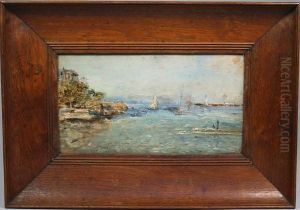Raoul Francois Larche Paintings
Raoul François Larche was a French sculptor known for his Art Nouveau style, characterized by dynamic, flowing lines and often incorporating figures of women and natural elements. Born on March 27, 1860, in Saint-André-de-Cubzac in Gironde, France, Larche was drawn to the arts at a young age. He moved to Paris to pursue his passion for sculpture and trained at the École des Beaux-Arts under the guidance of François Jouffroy and Alexandre Falguière, two prominent French sculptors of the time.
Larche began to exhibit his work at the Paris Salon from the early 1880s. He achieved success and recognition relatively early in his career, receiving a third-class medal in 1886 and a second-class medal in 1890. Larche's work is often noted for its sensuality and its embodiment of the Art Nouveau ethos, which was at its peak during the turn of the century. One of his most famous works is the 'Loïe Fuller' lamp, inspired by the American dancer Loïe Fuller who was known for her pioneering work with theatrical lighting and costume. This lamp perfectly captured the essence of movement and fluidity in Fuller's dance, becoming an iconic symbol of Art Nouveau design.
Larche's work was not limited to small decorative items; he also created large monuments and memorials, showcasing his versatility as an artist. His ability to work with a variety of materials, including marble, bronze, and ivory, allowed him to explore different textures and effects in his sculptures. Despite his success, Larche's life was relatively short. He died on July 28, 1912, in Paris, leaving behind a legacy of work that would influence future generations of sculptors and designers. His sculptures can be found in many public and private collections, as well as museums around the world, including the Musée d'Orsay in Paris.
